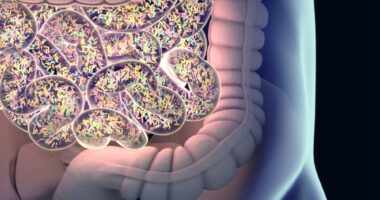Study Finds Risk Factors for Chronic Constipation in SSc Patients

The delayed passage of food waste through the colon — or slow colonic transit — is common and often severe in people with scleroderma, a study has revealed.
This condition was more likely in patients with widened blood vessels seen on the skin and less likely in those with worse lung function.
The study, “Slow colonic transit in systemic sclerosis: an objective assessment of risk factors and clinical phenotype,” was published in the journal Arthritis Care & Research and was led by researchers at Johns Hopkins University.
Systemic scleroderma, also known as systemic sclerosis (SSc), is characterized by the buildup of scar tissue in the skin and internal organs, including the heart, kidneys, lungs, and digestive tract.
About 50% of people with SSc experience slow colonic transit — the prolonged passage of waste through the large intestine. Although this can lead to severe complications, little is known about its specific clinical or blood-related (serological) features.
“The identification of clinical and serological features associated with colonic hypomotility is important in the diagnostic evaluation and risk stratification of SSc patients,” the scientists wrote.
SSc patients enrolled in the study underwent whole gut transit (WGT) studies, which measured the movement of food through the stomach and bowel, after having experienced significant digestive tract symptoms, such as nausea, vomiting, unintentional weight loss, bloating, diarrhea, or constipation.
Clinical and demographic data were collected at the first visit and every six months after that. Blood samples were withdrawn to identify disease-related antibodies, and participants were asked to avoid promotility agents, stool softeners, opiates, tranquilizers, and antibiotics three days before the study. Unless otherwise specified, slow colonic transit was defined as delayed waste transit at the final WGT study point of 72 hours (three days).
Altogether, the study included 100 SSc patients, of whom 88 were female. The mean average age was 57 years, and disease duration was 16 years. Sixty-nine participants had limited cutaneous SSc, and 31 had diffuse cutaneous SSc.
Slow colonic transit was identified in 48% to 60% of patients, depending on the time point measured (one, two, or three days). In those with normal transit, waste was mostly evacuated by three days. Colonic transit was most frequently delayed 60% after one day, 56% after two days, and 48% after three days.
Overall, a median of 4% had complete colon emptying after one day, 25% after two days, and 63% after three days. Among those with slow transit, the median percent colon emptying was significantly lower, with 5% complete emptying after three days. Also, in these patients, food transit was delayed in the esophagus (69%), the stomach (19%), and the small intestine (19%).
In comparing those with and without slow colonic transit, there was no significant difference in disease duration, nor was there an association between the severity of slow colonic transit and disease duration. Among patients with a disease duration of five years or less since the first non-Raynaud’s symptom, 44% had slow colonic transit, while in those with the disease for six to 15 years, 58% had slow transit. Also, 53% of participants with disease duration more than 15 years showed slow transit.
These results suggested that “patients do not develop a higher burden of colonic disease over time,” the researchers wrote. “Whether this implies that patients may develop slow colonic transit at any point during their disease course, or that specific environmental exposures increase the susceptibility of patient subsets to slow colonic transit independent of disease duration remains to be explained.”
SSc patients with slow colonic transit were more likely to have smoked (43% vs. 22%), be female (98% vs. 79%), have a Medsger score of three or more, which is a measure of digestive tract disease (27% vs. 9%), and have telangiectasia (89% vs. 67%), or small, widened blood vessels visible on the skin. Of the 12 male patients in the study, one had slow colonic transit.
“It appears that female sex is associated with slow transit constipation in the general population and also with slow colonic transit in patients with SSc,” the researchers added. “Our findings suggest that male patients may be less likely to suffer from slow colonic transit, however, further studies are warranted to validate this finding.”
Additionally, participants with slow colonic transit were less likely to have significant lung disease based on lung function tests. They also showed less severe diarrhea.
Antibody data was available for 75 patients, of whom 52 tested positive to at least one disease-related antibody. Slow colonic transit was significantly associated with the presence of anti-centromere autoantibodies (58% vs. 31%), which are common in people with SSc.
A simple statistical analysis found telangiectasia, digestive tract disease severity, anti-centromere autoantibodies, and being female were all significantly associated with slow colonic transit.
Those with significantly low lung function were less likely to have slow transit, but former smokers were more likely to have delayed transit (71% vs. 29%) than patients who never smoked or current smokers. Although few current smokers were in the study, regular transit was slightly more common in this group.
After adjusting for smoking history, telangiectasia, low lung function, and anti-centromere autoantibodies, the researchers found slow colonic transit was nearly four times more likely in patients with telangiectasia and 72% less likely in those with significantly low lung function.
“In conclusion, our study demonstrates that slow colonic transit is common and often severe in patients with SSc,” the researchers wrote. “Defining the clinical and serological characteristics of patients with slow colonic transit may help us identify high-risk patients, even when [digstive tract] symptoms are not specific, expediting diagnosis and treatment of colonic dysfunction.”
“Prospective longitudinal studies are needed to determine whether the presence of these clinical features at baseline [first examination] are useful in identifying patients at high risk of progressive slow colonic transit,” they added.








